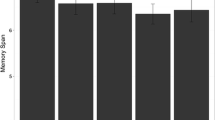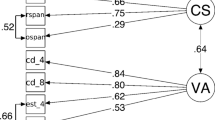Abstract
In this study, we examined the impact of concurrent verbal and spatial working memory demands on performance on an alpha-numeric successive target detection task. Seven hundred and forty-five participants performed a target detection task while simultaneously performing either a spatial or a verbal working memory task or they performed matched no-memory control tasks. The vigilance decrement, both an increase in target detection response times and a decrease in perceptual sensitivity A′ to target stimuli over time, was exacerbated by concurrent working memory load. The spatial and verbal working memory loads both impacted vigilance performance suggesting utilization of common executive resources. Overall, these results support the view that the vigilance decrement results from high cognitive resource demands (e.g., hard work), not from cognitive under-load (e.g., boredom or mindlessness).




Similar content being viewed by others
References
Ariga A, Lleras A (2011) Brief and rare mental “breaks” keep you focused: deactivation and reactivation of task goals preempt vigilance decrements. Cognition 118:439–443
Baddeley A (2007) Working memory, though, and action. Oxford University Press, New York
Boles DB, Law MB (1998) A simultaneous task comaparison of differentiated and undifferentiated hemispheric resource theories. J Exp Psychol Hum Percept Perform 24:204–215
Caggiano DM, Parasuraman R (2004) The role of memory representation in the vigilance decrement. Psycho Bull Rev 11:932–937
Carlson EB, Putnam FW (1993) An update on the dissociative experiences scale. Dissociation 6:16–27
Cheyne JA, Solman GJF, Carriere JSA, Smilek D (2009) Anatomy of an error: a bidirectional state model of task engagement/disengagement and attention-related errors. Cognition 111:98–113
Cowan N (1995) Attention and memory: an integrated framework. Oxford University Press, New York
Davies DR, Parasuraman R (1982) The psychology of vigilance. Academic Press, London
Dockree PM, Kelly SP, Roche RA, Hogan MJ, Reilly RB, Robertson IH (2004) Behavioural and physiological impairments of sustained attention after traumatic brain injury. Cogn Brain Res 20:403–414
Dockree PM, Bellgrove MA, O’Keefe FM, Moloney P, Aimola L, Cartoon S, Robertson IH (2006) Sustained attention in traumatic brain injury (tbi) and healthy controls: enhanced sensitivity with dual-task load. Exp Brain Res 168:218–229
Fan J, McCandliss BD, Fossella J, Flombaum JL, Posner MI (2005) The activation of attention networks. NeuroImage 26:471–479
Ganis G, Thompson WL, Kosslyn SM (2004) Brain areas underlying visual mental imagery and visual perception: an fMRI study. Cog Brain Res 20:226–241
Giambra LM (1995) A laboratory based method for investigating influences on switching attention to task unrelated imagery and thought. Conscious Cogn 4:1–21
Grier RA, Warm JS, Dember WN, Matthews G, Galinsky TL, Szalma JL, Parasuraman R (2003) The vigilance decrement reflects limitations in effortful attention not mindlessness. Hum Factors 45:349–359
Hancock PA, Warm JS (1989) A dynamic model of stress and sustained attention. Hum Factors 31:519–537
Helton WS, Russell PN (2011) The effects of arousing negative and neutral picture stimuli on target detection in a vigilance task. Hum Factors 53:132–141
Helton WS, Warm JS (2008) Signal salience and the mindlessness theory of vigilance. Acta Psychol 129:18–25
Helton WS, Dember WN, Warms JS, Matthews G (2000) Optimism, pessimism, and false failure feedback: effects on vigilance performance. Curr Psychol 18:311–325
Helton WS, Hollander TD, Warm JS, Matthews G, Dember WN, Wallart M, Beauchamp G, Parasuraman R, Hancock PA (2005) Signal regularity and the mindlessness model of vigilance. Brit J Psychol 96:249–261
Helton WS, Warm JS, Tripp LD, Matthews G, Parasuraman R, Hancock PA (2010) Cerebral lateralization of vigilance: a function of task difficulty. Neuropsychologia 48:1683–1688
Helton WS, Dorahy MJ, Russell PN (in press) Dissociative tendencies and right hemisphere processing load: effects on vigilance performance. Conscious Cogn
Helton WS, Head J, Russell PN (in press) Reliable and unreliable warning cues in the sustained attention to response task. Exp Brain Res
Hitchcock EM, Dember WN, Warm JS, Maroney BW, See J (1999) Effects of cueing and knowledge of results on workload and boredom in sustained attention. Hum Factors 41:365–372
Hitchcock EM, Warm JS, Matthews G, Dember WN, Shear PK, Tripp LD, Mayleben DW, Parasuraman R (2003) Automation cueing modulates cerebral blood flow and vigilance in a simulated air traffic control task. Theoret Issues Ergono Sci 4:89–112
Kane MJ, Engle RW (2002) The role of the prefrontal cortex in working memory capacity, executive attention, and general fluid intelligence: an individual differences perspective. Psycho Bull Rev 9:637–671
Lawrence NS, Ross TJ, Hoffman R, Garavan H, Stein EA (2003) Multiple neuronal networks mediate sustained attention. J Cogn Neurosci 15:1028–1038
Lim J, Wu W, Wang J, Detre JA, Dinges DF, Rao H (2010) Imaging brain fatigue from sustained mental workload: an ASL perfusion study of the time-on-task effect. NeuroImage 49:3426–3435
Mackworth NH (1948) The breakdown of vigilance during prolonged visual search. Q J Exp Psychol 1:6–21
Mackworth NH (1950) Researches on the measurement of human performance. Medical Research Council Special Report, No. 2680. H.M.S.O., London (Reprinted from Selected papers in the design and use of control systems, pp 174–331 by HW Sinaiko Ed., 1961, New York: Dover)
Macmillan NA, Creelman CD (2005) Detection theory: a user’s guide. Erlbaum, Mahwah
Manly T, Robertson IH, Galloway M, Hawkins K (1999) The absent mind: further investigations of sustained attention to response. Neuropsychologia 37:661–670
Manly T, Heutlink J, Davidson B, Gaynord B, Greenfield E, Parr A, Ridgeway V, Robertson IH (2004) An electronic knot in the hankerchief: content free cueing and the maintenance of attentive control. Neuropsychol Rehabil 14:89–116
Matthews G, Davies DR, Westerman SJ, Stammers RB (2000) Human performance: cognition, stress and individual differences. Psychology Press, East Sussex
Matthews G, Warm JS, Reinerman-Jones LE, Washburn DA, Tripp LD (2010) Task engagement, cerebral blood flow velocity, and diagnostic monitoring for sustained attention. J Exp Psychol Appl 16:187–203
O’Connell RG, Bellgrove MA, Dockree PM, Robertson IA (2006) Cognitive remediation in ADHD: effects of periodic non-contingent alerts on sustained attention to response. Neuropsychol Rehabil 16:653–665
Parasuraman R (1979) Memory load and event rate control sensitivity decrements in sustained attention. Science 205:924–927
Robertson IH, Manly T, Andrade J, Baddeley BT, Yiend J (1997) “Oops!”: performance correlates of everyday attentional failures in traumatic brain injured and normal subjects. Neuropsychologia 35:747–758
See JE, Howe SR, Warm JS, Dember WN (1995) A meta-analysis of the sensitivity decrement in vigilance. Psychol Bull 117:230–249
Shaw TH, Warm JS, Finomore V, Tripp L, Matthews G, Weiler E, Parasuraman R (2009) Effects of sensory modality on cerebral blood flow velocity during vigilance. Neurosci Lett 461:207–211
Smallwood J, Davies JB, Heim D, Finnigan F, Sudberry M, O’Conner R, Obonsawin M (2004) Subjective experience and the attentional lapse: task engagement and disengagement during sustained attention. Conscious Cogn 13:657–690
Smith EE, Jonides J, Koeppe RA (1996) Dissociating verbal and spatial working memory using PET. Cereb Cortex 6:11–20
Szalma JL, Warm JS, Matthews G, Dember WN, Wiler EM, Meier A, Eggemeier FT (2004) Effects of sensory modality and task duration on performance, workload, and stress in sustained attention. Hum Factors 46:219–233
Szalma JL, Hancock PA, Dember WN, Warm JS (2006) Training for vigilance: the effect of knowledge of results format and dispositional optimism and pessimism on performance and stress. Brit J Psychol 97:115–135
Temple JG, Warm JS, Dember WN, Jones KS, LaGrange CM, Matthews G (2000) The effects of signal salience and caffeine on performance, workload and stress in an abbreviated vigilance task. Hum Factors 42:183–194
Warm JS (1984) An introduction to vigilance. In: Warm JS (ed) Sustained attention in human performance. Wiley, Chichester, pp 1–14
Warm JS (1993) Vigilance and target detection. In: Huey BM, Wickens CD (eds) Workload transitions: implications for individual and team performance. National Academy Press, Washington, pp 139–170
Warm JS, Parasuraman R, Matthews G (2008) Vigilance requires hard mental work and is stressful. Hum Factors 50:433–441
Weissman DH, Roberts KC, Visscher KM, Woldorff MG (2004) The neural bases of momentary lapses of attention. Nat Neurosci 9:971–978
Author information
Authors and Affiliations
Corresponding author
Rights and permissions
About this article
Cite this article
Helton, W.S., Russell, P.N. Working memory load and the vigilance decrement. Exp Brain Res 212, 429–437 (2011). https://doi.org/10.1007/s00221-011-2749-1
Received:
Accepted:
Published:
Issue Date:
DOI: https://doi.org/10.1007/s00221-011-2749-1




